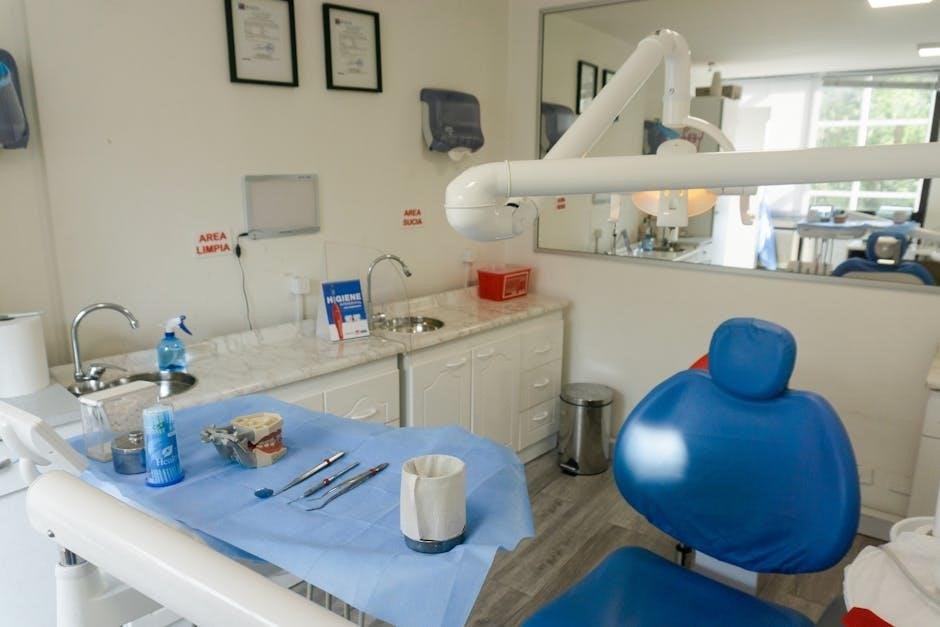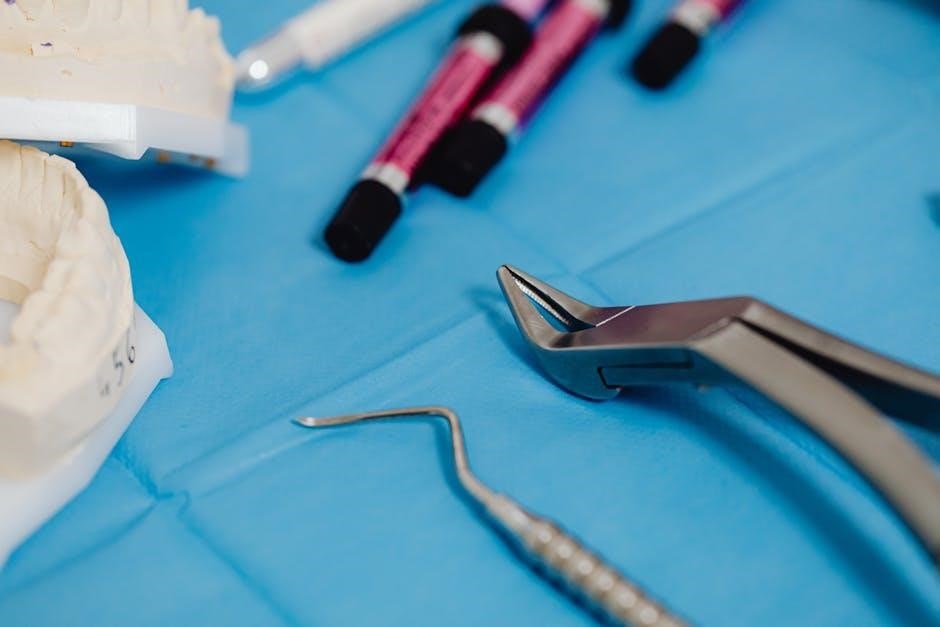A dental surgical guide is a custom-made tool used in implant procedures to ensure precise placement, minimizing swelling and pain. It aids in accurate drilling and planning, enhancing patient comfort and surgical accuracy with CAD software.
1.1 Definition and Purpose
A dental surgical guide is a custom-made tool used during implant procedures to ensure precise placement of dental implants. Its primary purpose is to guide the surgeon in accurately drilling and positioning implants based on preoperative planning. This tool is designed to fit the patient’s anatomy, minimizing errors and enhancing surgical efficiency. It also helps reduce swelling and post-operative pain, improving overall patient comfort and outcomes.
1.2 Importance in Modern Dentistry
Dental surgical guides are crucial in modern dentistry for their role in enhancing accuracy and precision during implant placements. They minimize surgical complications, reduce recovery time, and improve patient comfort. By providing a clear roadmap for surgeons, these guides ensure optimal implant positioning, which is vital for both functional and aesthetic outcomes. Their use aligns with the growing demand for efficient and reliable dental procedures, making them indispensable in contemporary implantology.

Types of Dental Surgical Guides
Dental surgical guides include traditional and computer-generated types. Traditional guides use radiographs, while modern ones utilize CAD software for precise implant placement, enhancing accuracy and customization.
2.1 Traditional Surgical Guides
Traditional surgical guides are created using radiographs and manual techniques. They provide a basic template for implant placement, relying on anatomical landmarks. While less precise than modern alternatives, they remain cost-effective and straightforward. These guides are often used in simpler cases but may lack the accuracy needed for complex procedures. They serve as a foundational tool in dental surgery, offering a starting point for implant placement planning.
2.2 Computer-Generated Surgical Guides
Computer-generated surgical guides are designed using advanced CAD software, offering high precision and customization. They integrate imaging data to create detailed plans, ensuring accurate implant placement. These guides reduce errors and enhance predictability. By streamlining the procedure, they minimize surgical time and patient discomfort. Computer-generated guides are particularly beneficial for complex cases, providing a digital blueprint for optimal results and improved patient outcomes.

The Process of Creating a Surgical Guide
Creating a surgical guide involves imaging, planning, and fabrication. It starts with detailed scans to map the patient’s anatomy, followed by precise digital planning to ensure accuracy and customization.
3.1 Imaging and Planning
Imaging and planning are critical steps in creating a surgical guide. Detailed CT scans or CBCT scans are used to map the patient’s anatomy, allowing for precise measurements. Computer-aided design (CAD) software is then utilized to plan the optimal implant placement, ensuring proper alignment and avoiding vital structures. This step minimizes complications and ensures the guide fits perfectly, guiding the surgeon with accuracy during the procedure;
3.2 Design and Fabrication
The design and fabrication of surgical guides involve creating a precise template using data from imaging. Advanced software generates a digital model, which is then used to produce the guide through 3D printing or milling. The guide is customized to fit the patient’s anatomy, ensuring accurate implant placement. Materials like acrylic resin are commonly used for durability and comfort. This step ensures the guide aligns perfectly with the patient’s teeth and surgical plan, facilitating smooth procedures.
Benefits of Using Surgical Guides
Surgical guides enhance accuracy, reduce recovery time, and improve patient comfort. They minimize swelling and pain, ensuring precise implant placement and optimal surgical outcomes.
4.1 Accuracy and Precision
Dental surgical guides ensure precise implant placement by providing a customized template for drilling and positioning. This minimizes errors and enhances the accuracy of the procedure.
Advanced computer-aided design software allows for detailed planning, ensuring implants are placed in optimal anatomical positions, reducing complications and improving long-term outcomes for patients.
4.2 Reduced Recovery Time
Dental surgical guides minimize tissue damage and swelling by ensuring precise implant placement, leading to faster healing and reduced post-operative pain for patients.
The use of these guides shortens surgery time and minimizes complications, promoting faster recovery and allowing patients to resume normal activities sooner with improved comfort and satisfaction.
4.3 Enhanced Patient Comfort
Dental surgical guides contribute to enhanced patient comfort by minimizing tissue damage and reducing swelling during implant placement. This precise technique ensures less discomfort and faster healing.
Patients experience reduced post-operative pain and a smoother recovery process. The use of surgical guides also shortens the procedure time, further improving the overall comfort and satisfaction of the patient.
Risks and Challenges
Despite their benefits, dental surgical guides pose risks such as potential complications and limitations, requiring precise planning and skilled execution to mitigate adverse outcomes effectively.
5.1 Potential Complications
Potential complications from dental surgical guides include improper fit, nerve damage, or implant misplacement. These issues can arise from inaccurate imaging or design flaws, leading to post-surgical discomfort or the need for corrective procedures. Ensuring precise customization and thorough preoperative planning is critical to minimizing risks and achieving successful outcomes for patients undergoing implant surgeries.
5.2 Limitations of Surgical Guides
Despite their benefits, surgical guides have limitations. Their effectiveness depends on accurate imaging and design, as errors in these stages can compromise precision. Additionally, the guide’s fit must be precise, and any anatomical variations or movement during surgery can affect outcomes. While they enhance accuracy, they are not foolproof, requiring skilled implementation to ensure optimal results and minimize potential issues during dental implant procedures.

Case Studies and Success Stories
Case studies highlight successful implant placements using surgical guides, demonstrating improved accuracy and patient satisfaction. These real-world examples showcase the effectiveness of guides in achieving optimal outcomes.

6.1 Successful Implant Placements
Studies reveal high success rates in implant placements using surgical guides. These tools enhance precision, ensuring implants are positioned accurately in the jawbone, improving stability and aesthetics. Patients benefit from reduced healing times and natural-looking results, with many cases showing long-term functionality and satisfaction. Real-world applications demonstrate how guides minimize complications, making them indispensable in modern implantology.
6.2 Patient Outcomes and Satisfaction
Patients consistently report high satisfaction with dental surgical guides, citing enhanced comfort and reduced recovery time. The precision of guided implant placement leads to natural-looking results and improved Functionality. Many patients appreciate the minimal swelling and pain post-procedure, contributing to overall contentment. Positive outcomes often result in increased confidence and quality of life, making surgical guides a preferred choice for implant procedures.
Future of Dental Surgical Guides
The future of dental surgical guides lies in advanced technologies like AI, machine learning, and 3D printing, enhancing precision and customization for improved patient outcomes and streamlined procedures.
7.1 Advancements in Technology
Advancements in technology, such as 3D printing and CAD software, are revolutionizing dental surgical guides. These tools enable highly accurate and customized implant placements, improving surgical precision. Integration with AI and machine learning allows for predictive simulations, enhancing pre-operative planning. Real-time data and virtual models further refine the process, ensuring minimal invasiveness and faster recovery times. These innovations are setting new standards for efficiency and patient care in modern dentistry.
7.2 Integration with Emerging Trends
Dental surgical guides are increasingly integrating with emerging trends like augmented reality and IoT. AR enables real-time visualization during surgery, while IoT facilitates data exchange between tools. AI-driven analytics improve predictive modeling for complex cases. These integrations enhance precision, reduce complications, and offer personalized solutions. As technology evolves, surgical guides are becoming indispensable in modern dentistry, bridging the gap between innovation and patient care.
Dental surgical guides have revolutionized implant procedures by enhancing accuracy and patient comfort. Their evolution with technology promises continued improvement in dental care outcomes.
8.1 Summary of Key Points
Dental surgical guides are essential tools in modern dentistry, offering accuracy and customization for implant placements. They integrate advanced imaging and CAD software to enhance precision, reducing complications and recovery time. These guides improve patient comfort and satisfaction, ensuring optimal outcomes. By streamlining the surgical process, they play a vital role in advancing dental implantology and improving overall patient care.
8.2 Final Thoughts on the Use of Surgical Guides
Dental surgical guides have revolutionized implant procedures by offering unmatched precision and customization. Their ability to enhance accuracy, reduce recovery time, and improve patient comfort makes them indispensable in modern dentistry. As technology advances, these tools will continue to evolve, further improving outcomes. Surgical guides are not just optional aids but essential components that elevate the quality and success of dental implant surgeries, benefiting both patients and practitioners alike.